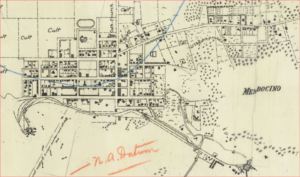This last month, the Kelley House received an interesting request from innkeeper Ken Taylor for an historic map that would show the grounds of the Joshua Grindle House. Our go-to vintage maps are the Sanborn Fire Insurance maps, but the northeast part of Mendocino, where the Grindle House is located, showed only a portion of his property.

So, we turned to our digital copy of the 1909 U. S. Coast and Geodetic Survey, a beautiful hand-drawn map, which did include the Joshua Grindle House – and much more.
Let’s take a walk up Little Lake Road, starting at its intersection with Lansing Street just north of Mendosa’s, to see what was there at the turn of the 19th century.
RAHLVES HOUSE. On the northeast corner of Lansing and Little Lake Road, there was a two-story house and workshop (now gone) built in 1884 by carpenter-undertaker August Rahlves. Later, the Catholic Church owned it and used it as a parsonage. It was demolished in 1935, but you can still see the excavated area where the building stood, next to the cemetery sign.
SAINT VINCENT’S CHURCH. The first Catholic Church, Saint Vincent’s, was built in 1864-65, and was located opposite the intersection of Howard Street. Nearby, on the west side of Lansing Street, the map also shows the original Saint Anthony’s, built in 1908, but destroyed by fire in 1929, then rebuilt. The older and much smaller church with its tall slender steeple stood 13 more years but was finally torn down in 1921. A large white cross within the cemetery marks its approximate location today.
CEMETERY. Hillcrest Cemetery (the “old” cemetery) is up the hill behind the church. It was often referred to as the Catholic Cemetery. Although they were Protestants, the Kelley family plot is up there. In 1909 it was much smaller in size than today’s non-denominational burial ground, which also encompasses the Chinese Cemetery, and Zenith Hill Veterans Memorial Cemetery, established in 1966.
DAN MILLIKEN HOUSE. This house belonged to early logging contractor Daniel Milliken and was later owned by the well-known Murray Family. Demolished in 1946, its ornate architectural embellishments resembled those on the early Ford House and the neighboring Spencer Hills House.
SPENCER HILLS HOUSE. Still located at the intersection of School Street, master carpenter J. D. Johnson built in 1885 a large addition to the original small house. The building in the rear marked with an X is the large barn associated with the Hills ranch.
JOSHUA GRINDLE HOUSE. Next door, this banker’s house was also built in 1885 by J. D. Johnson, with later work done by Perley Maxwell. In 1912, Perley built a tall three-tank water tower, replacing the one seen on the map. Ever the civic-minded man, Joshua’s tanks supplied water to other homes in the area, as well as feeding the 10,000-gallon redwood fire protection tank built in 1906 (now gone) at the southeast corner of School and Little Lake.
WARNER HOUSE. Erick and Matilda Warner’s House and water tower are next. A Swede by birth, Erick was a fruit and vegetable peddler, bringing fresh materials off the steamships each week. Wife Tillie’s 1941 obituary said that, “She will be remembered by a host of Mendocino school children who patronized the small confectionary shop kept by herself and husband. There she always treated them generously and had a cheery smile and a kind word for all.” Their stand would have been right across the street from the Grindle House in what we now call Friendship Park. To make room for 1960s highway construction, their house was moved down the street to the lot where the Milliken-Murray house once stood.
RAHLVES-SEMAN-BAUMGARTNER HOUSE. This house is still standing across Highway 1 on the northeast corner of Little Lake Road. It was built by the same Augustus Rahlves who constructed the house at the beginning of our walk, and later sold to Emil Seman, the town’s blacksmith. His daughter Lena married William Baumgartner, the first lighthouse keeper at Point Cabrillo. In her later years, kind-hearted Tillie Warner, who lived to the ripe old age of 91, was cared for here by Lena, her long-time friend and neighbor.
Each house has stories to tell. If you’d like to know more about your own neighborhood or research your family’s history, email the Kelley House Museum’s research office [email protected]